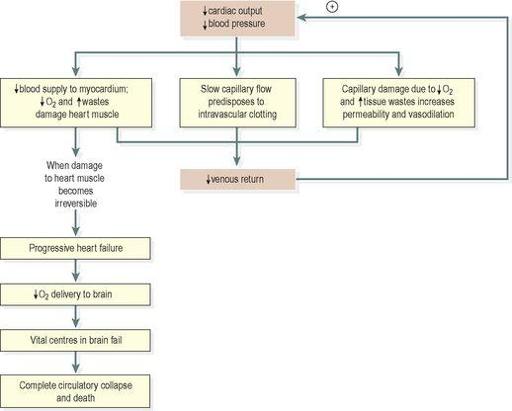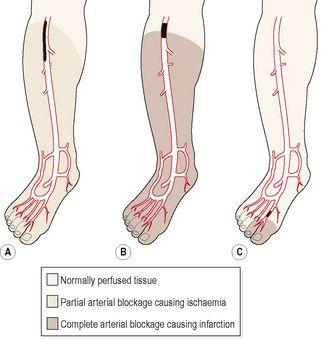Ross & Wilson Anatomy and Physiology in Health and Illness (51 page)
Read Ross & Wilson Anatomy and Physiology in Health and Illness Online
Authors: Anne Waugh,Allison Grant
Tags: #Medical, #Nursing, #General, #Anatomy

Figure 5.55
Uncompensated shock.
Eventually, the cardiovascular system reaches the stage when, although its compensatory mechanisms are running at maximum, it is unable to supply the brain’s requirements. As the brain, including the cardiovascular and respiratory centres in the brain stem, becomes starved of oxygen and nutrients, it begins to fail and there is loss of central control of the body’s compensatory mechanisms. Circulatory collapse follows. Finally, degenerating cardiovascular function leads to irreversible and progressive brain-stem damage, and death follows.
Thrombosis and embolism
Learning outcomes
After studying this section, you should be able to:
define the terms thrombosis, embolism and infarction
explain, in general terms, the effects of the above on the body
describe the main causes of venous thrombosis.
Embolus
This is a mass of any material carried in the blood. It is usually a fragment of a
thrombus
(an intravascular blood clot) from elsewhere in the vascular system, but other materials include:
•
fragments of atheromatous plaques (
p. 115
)
•
fragments of vegetations from heart valves, e.g. infective endocarditis (
p. 121
)
•
tumour fragments, which may cause metastases
•
amniotic fluid, during childbirth
•
fat, from bone fractures
•
air, from puncture of a blood vessel by a broken rib or during a clinical procedure
•
nitrogen bubbles in decompression sickness (the ‘bends’)
•
pus from an abscess.
Thrombus formation
The risk of a thrombus developing within a blood vessel is increased by any condition that slows blood flow, damages the smooth intimal lining of blood vessels or increases blood coagulability.
Blood flow is slowed
This may happen in immobility, e.g. prolonged sitting or in bedrest, or if a blood vessel is compressed by an adjacent structure such as a tumour, or if blood pressure is low for a prolonged period, as in shock.
Damage to the blood vessel intima
This may be caused by atherosclerosis or trauma.
Increased blood coagulability
Factors here include oestrogen (either naturally produced or taken in oral contraceptive drugs), dehydration, pregnancy and childbirth, the presence of an intravenous cannula, some malignant diseases and some disorders of blood clotting.
Emboli originating in an
artery
travel away from the heart until they reach an artery too narrow to let them pass, and lodge there, partly or completely blocking blood supply to distal tissues. Emboli originating in veins travel towards the heart, and from there travel to the lungs in the pulmonary artery. They then lodge in the first branch too narrow to let it pass. Lung tissue supplied by the blocked vessel becomes ischaemic and dies (pulmonary embolism). There may be multiple small emboli or one or more large ones. Massive pulmonary embolism blocks a main pulmonary artery and usually causes sudden collapse and death.
Infarction
This is the term given to tissue death because of interrupted blood supply. The consequences of interrupting tissue blood supply depend on the size of the artery blocked and the function of the tissues affected.
Ischaemia
means tissue damage because of reduced blood supply (
Fig. 5.56
).
Figure 5.56
Ischaemia and infarction. A.
Partial blockage but normal perfusion.
B, C.
Complete blockage causes distal tissue ischaemia and infarction, dependent on the location of the blockage.
Embolism
Embolism occurs when a travelling embolus, whatever its nature, lodges in and obstructs a blood vessel. The most serious consequences include pulmonary embolism, or blockage of a coronary artery (myocardial infarction,
p. 121
) or a cerebral artery (cerebral infarction,
p. 175
).
Blood vessel pathology
Learning outcomes
After studying this section, you should be able to:
discuss the main causes, effects and complications of arterial disease, including atheroma, arteriosclerosis and aneurysm
discuss the underlying abnormality in varicose veins



